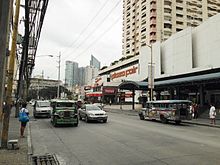Road in the Philippines
Chino Roces Avenue, formerly known as (and still commonly referred to as) Pasong Tamo, is a prominent north–south road in the cities of Makati and Taguig, Metro Manila, Philippines. It runs for 5.80 kilometers (3.60 miles) from Olympia and Tejeros to Fort Bonifacio.[1] The avenue is named after the Filipino journalist Joaquin "Chino" Roces. The fact that the avenue is the location of various media establishments influenced the renaming.[2][3]
Etymology
The avenue is named after Joaquin "Chino" Roces, a journalist who is the founder of The Manila Times and Associated Broadcasting Company (now TV5) and an opposition figure during the Marcos Sr. administration.
It is commonly known by its former name, Pasong Tamo, which may come from:
- an indigenous plant called tamo that once grew there abundantly;[4] or
- a barrio in Caloocan (now a barangay in Quezon City) where the Battle of Pasong Tamo occurred, as suggested by surrounding streets in Olympia and Tejeros named similar to places that played significant roles during the Philippine Revolution (e.g. Malolos, Barasoain, Novaliches, Binakod, Zapote).
Route description
The northern end of Chino Roces Avenue is at the intersection with J. P. Rizal Avenue. It heads southwesterly across the residential and commercial barangays of Olympia, Tejeros, Santa Cruz, and La Paz. After the intersection with Yakal Street in San Antonio, the avenue bends to the south, becoming more commercial as it approaches Gil Puyat Avenue. The road continues southwards through the western limits of the Makati CBD, bending slightly southwesterly between Dela Rosa and Don Bosco Streets. The avenue then becomes mixed commercial and industrial as it continues on a straight route to EDSA.
South of EDSA via a narrow channel under the Magallanes Interchange, its extension serves as a frontage road to South Luzon Expressway. It is lined with light industries and car dealerships on both sides, as well as a few factory outlets, in an area also known as Mantrade or Kayamanan-C.[5] The road ends at Lawton Avenue within Fort Bonifacio in Taguig, near the New Philippine Senate Building and Sales Interchange . Chino Roces has a short extension north of J. P. Rizal Avenue into Barangay Carmona as A. P. Reyes Avenue. The part of Chino Roces from Rufino Street to Arnaiz Avenue is home to several Japanese restaurants and shops, earning it the nickname "Little Tokyo".[6]
History
The avenue originated as a short street in what was historically known as Malolos Subdivision, a residential subdivision in Tejeros and Olympia.[7] It was then extended towards Ocampo Street in the 1940s and later towards southern Makati circa 1950s,[4] making it a major road.[5][8][9] It was later extended south of EDSA towards Taguig.[10] Originally called Pasong Tamo, it was renamed Chino Roces Avenue.


